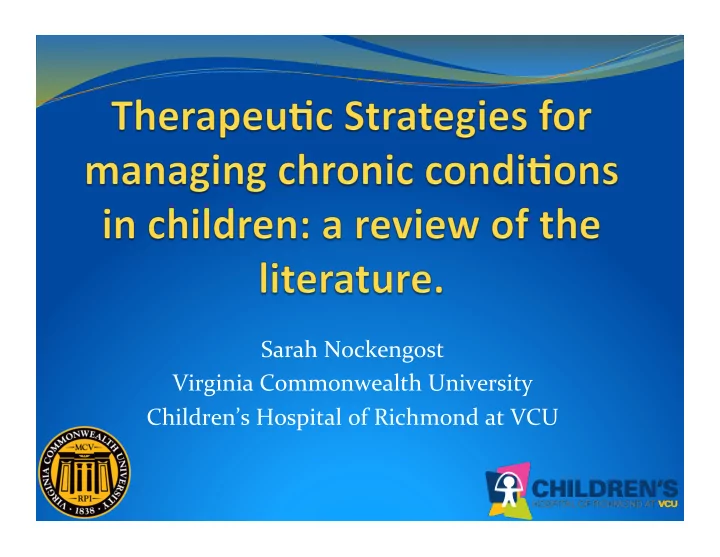

Sarah ¡Nockengost ¡ Virginia ¡Commonwealth ¡University ¡ Children’s ¡Hospital ¡of ¡Richmond ¡at ¡VCU ¡
Objec&ves ¡ Define ¡three ¡chronic ¡conditions ¡commonly ¡seen ¡in ¡ children ¡receiving ¡services ¡at ¡an ¡outpatient ¡therapy ¡ setting, ¡and ¡discuss ¡theories ¡behind ¡these ¡conditions. ¡ Highlight ¡risk ¡factors ¡for ¡developing ¡chronic ¡ symptoms. ¡ Review ¡literature ¡regarding ¡therapeutic ¡interventions ¡ for ¡such ¡chronic ¡conditions. ¡
Chronic ¡Condi&ons ¡in ¡Children ¡ “Chronic ¡Pain” ¡ Complex ¡Regional ¡Pain ¡Syndrome ¡ Amplified ¡Musculoskeletal ¡Pain ¡Syndrome ¡ Reflex ¡Sympathetic ¡Dystrophy ¡ Conversion ¡Disorder ¡ Persistent ¡Post-‑Concussion ¡Syndrome ¡
What ¡is ¡chronic ¡pain? ¡ Pain ¡that ¡persists ¡or ¡consistently ¡re-‑occurs ¡for ¡more ¡than ¡ 3 ¡months, ¡and ¡does ¡not ¡respond ¡to ¡traditional ¡treatment. ¡ It ¡may ¡arise ¡from ¡an ¡acute ¡injury, ¡or ¡there ¡may ¡be ¡no ¡ clear ¡cause ¡at ¡all. ¡ Chronic ¡pain ¡is ¡functionally ¡debilitating ¡in ¡may ¡ways, ¡ and ¡has ¡been ¡associated ¡with ¡numerous ¡psychological ¡ factors. ¡ Currently, ¡anywhere ¡from ¡11-‑38% ¡of ¡children ¡and ¡ adolescents ¡suffer ¡from ¡chronic ¡pain ¡in ¡some ¡form. ¡ (King, ¡2011) ¡
Chronic ¡vs. ¡Acute ¡Pain ¡ (Hasmi, ¡2013) ¡ “Shape ¡Shifting ¡Pain” ¡– ¡an ¡imaging ¡study ¡examining ¡brain ¡ activity ¡in ¡adults ¡with ¡sub-‑acute ¡vs. ¡chronic ¡back ¡pain. ¡ Cross-‑sectional: ¡2 ¡distinct ¡patterns ¡of ¡brain ¡activity ¡in ¡SBP ¡vs. ¡CBP ¡ Longitundinal: ¡brain ¡circuitry ¡shifts ¡from ¡pain-‑related ¡to ¡emotion-‑related ¡ in ¡persistent ¡SBP. ¡ Authors’ ¡conclusion: ¡ ¡ “Brain ¡activity ¡related ¡the ¡to ¡perception ¡of ¡back ¡pain ¡shifts ¡in ¡location ¡ from ¡regions ¡involved ¡in ¡acute ¡pain ¡to ¡engage ¡emotion ¡circuitry ¡as ¡the ¡ condition ¡persists, ¡thereby ¡providing ¡a ¡percept-‑linked ¡brain ¡signature ¡for ¡ transition ¡to ¡chronic ¡pain.” ¡
Theories ¡Behind ¡Chronic ¡Pain ¡ (Louw, ¡2013) ¡ Pain ¡Neuromatrix ¡Theory: ¡ Pain ¡is ¡a ¡brain ¡construct ¡and ¡is ¡shaped ¡by ¡a ¡wide ¡variety ¡of ¡ signals. ¡ Pain ¡is ¡a ¡multiple ¡system ¡output ¡activated ¡by ¡the ¡brain ¡based ¡on ¡perceived ¡ threat. ¡ Injury ¡and ¡pain ¡are ¡NOT ¡synonymous. ¡ Ion ¡channel ¡production ¡may ¡result ¡in ¡increased ¡nerve ¡ sensitivity ¡post-‑injury. ¡ Injury ¡or ¡threat ¡produces ¡a ¡higher ¡concentration ¡of ¡ion ¡channels ¡ sensitive ¡to ¡that ¡stimulus. ¡ Injury ¡does ¡not ¡merely ¡produce ¡pain. ¡ Cortisol ¡levels ¡rise ¡in ¡response ¡to ¡stress, ¡which ¡increases ¡blood ¡ glucose, ¡weakens ¡the ¡immune ¡system, ¡and ¡increases ¡inflammatory ¡ responses. ¡ Immobility ¡can ¡cause ¡“smudging” ¡of ¡the ¡homonculus. ¡
Theories ¡Behind ¡Chronic ¡Pain ¡ (Sherry, ¡2013) ¡ ¡ Abnormal ¡Spinal ¡Reflex ¡Arc ¡ Signals ¡sent ¡up ¡the ¡spinal ¡cord ¡to ¡be ¡interpreted ¡as ¡pain ¡ are ¡interrupted ¡due ¡to ¡an ¡abnormal ¡“short ¡circuit.” ¡ Signals ¡are ¡sent ¡to ¡sympathetic ¡neurovascular ¡bundles ¡ that ¡vasoconstrict ¡blood ¡vessels ¡and ¡decrease ¡oxygen ¡ causing ¡pain. ¡ Induces ¡a ¡vicious ¡cycle ¡stimulating ¡sympathetic ¡nerves ¡ which ¡amplifies ¡the ¡symptoms ¡and ¡pain ¡experience ¡long ¡ after ¡the ¡initial ¡stimulus ¡is ¡removed. ¡
Risk ¡Factors ¡for ¡Developing ¡Chronic ¡ Pain ¡ (Sherry, ¡2000; ¡Sherry, ¡2013; ¡Louw, ¡2013) ¡ Chronic ¡pain ¡has ¡been ¡correlated ¡with ¡the ¡presence ¡of ¡ several ¡potentially ¡modifiable ¡psycho-‑social ¡risk ¡factors: ¡ Fear ¡avoidance ¡behavior ¡and ¡pain ¡catastrophization ¡ Depression, ¡anxiety ¡or ¡other ¡psychological ¡distress ¡ Hormones ¡ Environmental ¡stress ¡ Family ¡stress ¡ Lack ¡of ¡education ¡or ¡previous ¡pain ¡experience ¡ Chronic ¡pain ¡has ¡also ¡been ¡associated ¡with ¡chronic ¡health ¡ conditions ¡in ¡children. ¡ Ex: ¡Ehler’s ¡Danlos, ¡Juvenile ¡Rheumatoid ¡Arthritis, ¡cancer ¡
What ¡is ¡Conversion ¡Disorder? ¡ (Soares, ¡2014) ¡ Involves ¡symptoms ¡or ¡deficits ¡affecting ¡voluntary ¡ motor ¡or ¡sensory ¡function ¡that ¡cannot ¡be ¡explained ¡ by ¡medical ¡evaluation. ¡ May ¡occur ¡because ¡of ¡a ¡psychological ¡conflict ¡and ¡ symptoms ¡usually ¡begin ¡after ¡a ¡stressful ¡experience. ¡ Most ¡common ¡symptoms ¡are ¡the ¡inability ¡to ¡speak ¡ and ¡paralysis. ¡ Prevalence ¡of ¡conversion ¡disorder ¡ranges ¡from ¡1-‑6% ¡ depending ¡on ¡the ¡setting ¡(typically ¡higher ¡in ¡ outpatient ¡or ¡neurological ¡clinics). ¡
E&ology ¡of ¡Conversion ¡Disorder ¡ (Leary, ¡2003) ¡ Some ¡studies ¡have ¡shown ¡that ¡adults ¡with ¡conversion ¡ disorder ¡had ¡abnormally ¡long ¡motor ¡reaction ¡times, ¡ but ¡normal ¡duration ¡motor ¡responses. ¡ Opposite ¡findings ¡compared ¡to ¡organic ¡motor ¡disorders ¡ Indicates ¡an ¡issue ¡with ¡motor ¡task ¡initiation. ¡ Imaging ¡studies ¡have ¡shown ¡changes ¡in ¡areas ¡of ¡the ¡ brain ¡involved ¡with ¡motor ¡inhibition. ¡ Changes ¡were ¡no ¡longer ¡evident ¡after ¡recovery, ¡ suggesting ¡a ¡transient ¡functional ¡disorder ¡in ¡circuits ¡ controlling ¡sensory ¡and ¡motor ¡function. ¡
Risk ¡Factors ¡for ¡Conversion ¡ Disorder ¡ (Leary, ¡2003) ¡ Anxiety ¡or ¡depression ¡ Rigid ¡personality ¡traits ¡ EX: ¡OCD ¡behaviors, ¡lack ¡of ¡flexibility, ¡low ¡stress ¡ tolerance, ¡poor ¡anger ¡control ¡ Domestic ¡stress ¡ Feelings ¡of ¡parental ¡rejection ¡or ¡poor ¡communication ¡ among ¡family ¡members ¡ Unresolved ¡guilt ¡ Unhappiness ¡in ¡school ¡
What ¡is ¡Persistent ¡Post-‑Concussion ¡ Syndrome ¡(PCS)? ¡ (Graham, ¡2014; ¡Barlow, ¡2010) ¡ The ¡persistence ¡of ¡a ¡constellation ¡of ¡physical, ¡ cognitive, ¡emotional, ¡and ¡sleep ¡symptoms ¡beyond ¡the ¡ usual ¡recovery ¡period ¡after ¡a ¡concussion. ¡ Recovery ¡is ¡considered ¡prolonged ¡when ¡lasting ¡for ¡ more ¡than ¡2-‑3 ¡weeks. ¡ However ¡PCS ¡symptoms ¡can ¡persist ¡for ¡months ¡or ¡even ¡ years. ¡ An ¡epidemiology ¡study ¡of ¡persistent ¡post-‑concussion ¡ syndrome ¡found ¡that ¡13.7% ¡of ¡school ¡aged ¡children ¡ were ¡still ¡symptomatic ¡3 ¡months ¡after ¡mTBI. ¡
E&ology ¡of ¡Persistent ¡PCS ¡ (Silverberg, ¡2011) ¡ Specific ¡etiology ¡is ¡under ¡debate ¡and ¡largely ¡ unknown. ¡ Some ¡researchers ¡hypothesize ¡a ¡biopsychosocial ¡ model ¡in ¡which ¡pre-‑ ¡and ¡post-‑injury ¡factors ¡play ¡a ¡ role. ¡ Severity ¡of ¡injury ¡ Diverse ¡range ¡of ¡genetic, ¡developmental, ¡social, ¡ psychological, ¡biological ¡resilience, ¡and ¡vulnerability ¡ factors ¡contribute ¡to ¡good ¡and ¡bad ¡outcomes ¡
Risk ¡Factors ¡for ¡PCS ¡ (Silverberg, ¡2011) ¡ Severity ¡of ¡injury ¡ Loss ¡of ¡consciousness, ¡post-‑traumatic ¡amnesia, ¡and ¡ greater ¡symptom ¡severity ¡in ¡the ¡first ¡24 ¡hours. ¡ >4 ¡symptoms ¡of ¡concussion ¡ History ¡of ¡concussion ¡ Injury ¡to ¡the ¡neck ¡or ¡other ¡parts ¡of ¡the ¡body ¡ Contextual ¡circumstances ¡(i.e. ¡MVA ¡vs ¡sport’s ¡related) ¡ Psychological ¡distress ¡ Certain ¡pre-‑existing ¡personality ¡traits ¡(anxiety, ¡ depression, ¡perfectionism) ¡ ¡
Recommend
More recommend